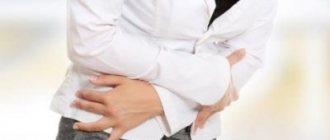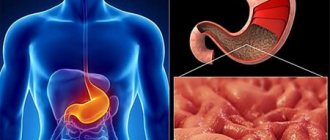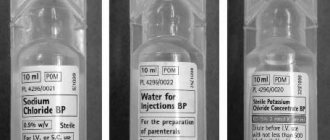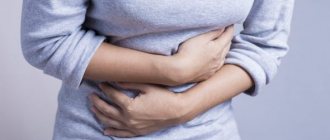- Types of internal gastric hernias
- How the disease develops
- Causes
- Symptoms
- Diagnostics
- Treatment
- Nutrition
- Operation
Modern medicine identifies several types of gastric hernias. Depending on their location, they can be external or internal.
With external abdominal organs, along with part of the peritoneum, they emerge through weak areas of the muscular wall of the abdominal area. Internal are characterized by the entry of organs, normally located in the abdominal cavity, into the chest through an opening in the diaphragm.
There is still controversy regarding how a gastric hernia should be treated. Some doctors are confident that the only effective method is surgery, while others argue that surgery can only be used in cases of giant hernias, and the emphasis should be on conservative therapy.
Types of internal gastric hernias
Types of hiatal hernia
There are two types of sliding hernias: fixed and non-fixed. There are also three main subtypes of sliding hernias:
- traction;
- pulsion;
- mixed.
The main role in the formation of the first type is played by the traction mechanism, which occurs during contraction of the esophageal longitudinal muscles.
The development of pulsion type hernias is due to several factors:
- constitutional weakness of the intermediate (interstitial) tissue;
- age-related involution;
- presence of obesity;
- pregnancy;
- circumstances leading to increased intra-abdominal pressure.
Sliding gastric hernias often provoke the development of insufficiency of the lower esophageal sphincter, which becomes the cause of gastroesophageal type reflux.
How the disease develops
The abdominal and thoracic cavities are separated by a diaphragm - a thin plate of muscle tissue that serves to separate these cavities and isolate the lungs, heart and aorta from the abdominal organs: stomach, liver, large, small intestine, etc. The diaphragm has a large opening for the esophagus. In normal conditions, the diameters of the esophagus and opening are equal. For certain reasons, the esophageal opening expands, as a result of which part of the stomach, and in severe cases the entire stomach, penetrates into the chest cavity. An increase in the size of the esophageal opening of the diaphragm can be provoked even by the seemingly harmless habit of eating heavily, and then lying on the sofa for hours or, conversely, doing heavy physical labor on a full stomach. As a result, the following often begin to appear:
- heartburn;
- belching;
- pain localized in the chest area;
- interruptions in heart function.
Such phenomena occur as a result of the penetration of gastric contents into the esophagus due to the incorrect functioning of the cardiac sphincter - a muscle ring that closes the transition from the esophagus to the gastric chamber.
Is a gastric hernia dangerous?
Today, some experts believe that in the situation with a gastric hernia, the colors are somewhat thickened: many patients feel quite normal until the moment when, during an examination, a hernia is suddenly discovered. Having read all sorts of pseudo-scientific literature, such patients torment themselves and those around them with their slightly exaggerated suffering. This fact is evidence that, to a certain extent, gastric hernia is a psychosomatic type of disease.
Features and mechanisms of development
Gastric hernia - what is it and how to treat pathological protrusion? The diaphragm is a thin plate of connective muscle tissue, which is laid between the sternum and the abdominal cavity, and is a kind of demarcation between them. The diaphragm has openings through which nerve endings, tendons, ligaments and the esophagus pass.
The muscles of the diaphragmatic opening are dense, elastic, and contract regularly, controlling the passage of the bolus of food from the esophagus to the stomach. When food enters the esophagus, the sphincter expands, and when it enters, it contracts to prevent the return of a bolus of food from the stomach.
When muscle tone relaxes, the diaphragmatic sphincter stops contracting fully, expands, and the food opening becomes much larger. Through this hole, adjacent organs begin to communicate. Thus, the esophagus and stomach can prolapse into the thoracic regions. Hernial protrusions can form by two main mechanisms:
- developmental anomalies of the diaphragm, stomach and esophagus (anatomically formed hernias);
- the result of the disease, provoking factors (acquired, anatomically formed hernias).
An undoubted advantage in the formation of hernias is the possibility of treatment using a conservative method. However, if such a tumor is strangulated, adequate treatment is urgent surgery aimed at preserving part of the stomach.
Note! The disease is common in patients over 50 years of age against the background of existing gastroenterological pathologies. The risks of developing a gastric hernia are also due to a hereditary factor, and age does not matter.
Causes
- When working with weights, always pay attention to your technique!
The main reasons leading to the development of a gastric hernia are age-related degenerative processes in the body.
- The disease is often accompanied by an increase in intra-abdominal pressure and can be caused by it. The causes of high pressure inside the abdominal cavity are:
- chronic constipation;
- accumulation of gases in the stomach;
- significant physical activity - for example, lifting weights;
- intense sports activities;
- blunt abdominal trauma;
- complicated or multiple births.
- The cause of the disease is sometimes the incorrect functioning of the stomach, its bloating.
- Of great importance in the appearance of external hernias is the congenital weakness of the connective tissue structures of the abdominal wall or their weakening due to certain reasons.
As a person grows older, body tissues undergo certain changes. They are primarily associated with biomechanical weakening. Many people, having reached old age, continue to do strenuous physical work and lift heavy objects out of habit. If in youth strong muscles could easily withstand such a load, then after reaching a certain age, even small overloads can be excessive for weakened muscle fibers and tissues. Not only physical work, but also straining, sneezing and prolonged coughing sometimes provoke the appearance of a hernial protrusion.
5. External hernias can develop as a result of the presence of defects of various origins on the abdominal wall. Such defects are formed as a result of an injury or surgery. In these cases, the formation of a gastric hernia goes unnoticed by the patient himself, regardless of physical activity, severe stress, etc. Under such circumstances, the pathology is caused primarily by acquired weakness of the connective tissue of the abdominal wall.
Weakening of connective tissue structures may be a consequence of:
- bad heredity;
- sudden decrease in body weight;
- flabbiness due to age or previous illnesses;
- being overweight;
- pregnancy and associated stretching of the muscle wall;
- ascites.
Causes of gastric hernia
The main impetus for the occurrence of gastric hernias is increased intra-abdominal pressure. It may be caused by constipation that has become chronic, excessive production of gases, the consequences of blunt traumatic effects on the abdomen, or lifting heavy loads. The occurrence of hernial protrusions of the stomach is caused by pathological processes in the work of the organ itself, its excessive inflation. As a hernia develops, the esophageal opening of the diaphragm begins to stretch and, as a result, the gastric wall falls into the peritoneal cavity. The organ can also exit through the opening of the esophagus into the chest.
A hernia of the diaphragm and a hernia of the esophagus can also occur for less common reasons:
1. Excessive consumption of alcoholic beverages. Not only strong wine and vodka products lead to pathology, but also beer, as well as low-alcohol drinks. To prevent the occurrence of a hernia, it is worth limiting alcohol consumption to 2 times a month.
2. Another bad habit is smoking. It harms the entire body and affects all organs and systems. It also has a detrimental effect on the stomach, which often leads to surgical treatment methods.
3. The habit of constantly overeating is a direct path to the appearance of a gastric hernia. More often, such situations occur under the influence of stressful situations. It is necessary to strictly control how much food to eat. This also applies to large amounts of liquid, which can overstretch the walls of the stomach.
4. Obesity leads to a large number of diseases, and due to disruption of the main types of metabolism, it can also lead to the development of a hernia.
Symptoms
1. The very first and, perhaps, main symptom of a gastric hernia is pain. In most cases, the sensations described by patients resemble the complaints of patients diagnosed with reflux esophagitis. It is believed that this pathology precedes a gastric hernia, which is responsible for their similar symptoms.
Sometimes the pain syndrome resembles angina pectoris, or, as it is also called, angina pectoris. To clarify the diagnosis, radiography is prescribed. The similarity of the symptoms of these two pathologies, completely different in origin, is explained by the fact that during a hernia, the organs of the abdominal part move to the thoracic part, as a result of which pain is often localized in the retrosternal or epigastric region, sometimes radiating to the scapula or neck.
Pain may be present all the time or occur in certain situations:
- after eating (especially when overeating);
- in a lying position;
- when bending forward;
- during or after physical activity.
2. Another essential symptom of a gastric hernia is belching that is bitter or sour. It appears due to the penetration of stomach contents into the esophagus.
3. Heartburn - this symptom manifests itself especially clearly under the following circumstances:
- while performing physical work;
- in a horizontal position;
- with a forward tilt;
- as a result of overeating;
- after drinking alcoholic beverages.
4. Dysphagia, or a violation of the swallowing process - as a rule, indicates an exacerbation of the disease and the likelihood of developing complete esophageal obstruction over the next few days.
5. Bleeding - mainly manifested by the appearance of traces of blood in the stool and the presence of signs of anemia. It is necessary to note cases of completely asymptomatic gastric hernia, when it does not cause discomfort and was discovered completely by chance during a diagnostic examination for another disease.
Gastric hernia symptoms
As with most pathologies, the leading symptom of a gastric hernia is pain. Clinically, the manifestations are similar to the clinical picture of reflux esophagitis. The symptoms are similar for a reason; this pathology precedes the appearance of hernias. Since pain occurs in the chest, it is often confused with cardiac pathology - angina pectoris (angina pectoris). Sometimes the pain can radiate to the scapula or left shoulder, which is very similar to the clinical picture of myocardial infarction. To confirm the diagnosis of a hernia, a plain radiography of the abdominal organs is performed. The time of onset of a painful attack may vary. More often it manifests itself after excessive consumption of food, in a vertical position of the body, when bending the torso forward, during performance or after physical activity. A characteristic manifestation of the symptoms of a gastric hernia is belching of sour or bitter contents. Its nature is due to the reflux of gastric contents into the esophageal section of the gastrointestinal tract.
Heartburn, as a rule, occurs during physical stress, positioning the body in a horizontal plane, bringing the body forward, as a result of overeating, after consuming alcohol.
Dysphagia became a rarer, but still present, symptom. This is a swallowing disorder. Most often occurs during exacerbation of the pathological process. It may precede the development of complete obstruction of the esophagus over the next few days.
The most dangerous sign may be bleeding. It is manifested by the presence of blood in feces and low levels of hemoglobin and red blood cells in a general blood test - anemia. The course of the disease may be asymptomatic. In some cases, a gastric hernia is discovered during routine medical examinations or by chance, during the diagnosis of other pathologies.
Sliding Hernia Clinic
The clinical picture of sliding gastric hernias has some differences. It is mainly caused by progressive reflux esophagitis, which is the reflux of the contents of the gastric chamber back into the esophagus.
1. A high content of hydrochloric acid and enzymes leads to irritation and significant damage to the mucous membrane of the esophagus, which results in ulcerative and erosive changes.
2. The main complaints of patients with a sliding hernia are pain localized in the epigastric region and hypochondrium. In most cases they are burning or dull. Very often the pain radiates to the left shoulder or shoulder blade. The similarity of the clinic with the symptoms of cardiac pathologies (in particular, coronary insufficiency) leads to the fact that such patients are sometimes treated by cardiologists for a long time.
The intensity of pain increases:
- when changing body position;
- physical activity;
- tilt.
3. The pain syndrome is accompanied by regurgitation, belching and heartburn.
4. As the disease progresses, it becomes more difficult for food to move through the esophagus and swallow.
5. The possibility of hidden bleeding, the source of which is erosion and ulcers of the esophagus, cannot be excluded. Its manifestations are bloody vomiting that is bright red or the color of coffee grounds, and dark stools.
Symptoms of change
Due to the absence of symptoms for a long time, glaucoma is difficult to diagnose in the initial stages. Often the first signs of an onset of illness are blurred and are attributed to other diseases.
For timely detection of the disease, you should be regularly examined by an ophthalmologist. Changes in intraocular pressure are difficult to notice by yourself.
When symptoms are detected on your own, the disease is often already in a very advanced state. The table shows signs of increased and decreased intraocular pressure.
- blurred vision;
- rare blinking;
- atrophy and retraction of the eyeball;
- lack of shine;
- change in field of view.
- pain in the forehead, throbbing in the temples, migraine;
- destruction of the vitreous body;
- severe pain, stinging in the eyes;
- deterioration, blurred vision;
- decreased peripheral vision and field of vision;
- blurry rainbow circles when looking at the light;
- worsening dark adaptation, tearfulness;
- heaviness, fatigue in the eye sockets;
- redness of the eyes.
Without correction of pressure in the tissues of the eye, irreversible changes can occur.
Intraocular pressure increases due to increased production of intraocular fluid, congenital structural features of the eye, and cardiovascular diseases can also be the cause.
Less common is low intraocular pressure - this condition develops due to injury or complications after surgery, as well as due to underdevelopment of the eyeball. Low intraocular pressure is dangerous because the nutrition of the eye is disrupted, and this can lead to the death of eye tissue.
Eye pressure is increased due to increased production of intraocular fluid, congenital structural features of the eye, and cardiovascular diseases can also be the cause.
Increased intraocular pressure is often the cause of the development of such a serious pathology as glaucoma.
An imbalance in the production and outflow of intraocular fluid leads to its accumulation, which causes an increase in eye pressure in glaucoma. First, visual acuity decreases, then peripheral vision is impaired, the visibility zone is limited, and, as a result, complete blindness occurs.
These changes are irreversible, so timely diagnosis and treatment of the disease is important. Glaucoma can occur with normal intraocular pressure, but in this case there is a sharp deterioration in blood circulation in the optic nerve and disruption of its functions.
READ MORE: Can a child be given hematogen and at what age – benefits
Before starting treatment or drawing up a plan for using medications for low-tension glaucoma, you should study the main signs that are characteristic of this type of disease:
- The intraocular pressure (IOP) reading is often between 16 and 19 millimeters of mercury, but in many cases the level is less than 15 millimeters of mercury. Characterized by asymmetry in the manifestation of the disease. With greater damage to the optic nerve, there will be a correspondingly higher IOP level.
- Visual signs: the peripapillary zone undergoes changes along with the optic nerve in the same way as changes in the case of the manifestation of the primary open-angle form of the disease; hemorrhages (rashes, eruptions) located in the extreme positions of the disc are to a greater extent signs of low-pressure glaucoma and can indicate an increase in the degree of change in the nerves of the retina.
- Manifestations of defective signs of the visual field are practically indistinguishable from angle-closure glaucoma, although it has been proven that with pathology of low pressure they are located closer to the central part and are more pronounced. There are cases when, even in the absence of treatment for the disease, these changes remain at the initial stage of development and do not progress. But, nevertheless, if the disease is started and diagnosed at a late stage of development of low-tension glaucoma, it can lead to more severe damage compared to primary open-angle glaucoma.
Other distinguishing signs of low-tension glaucoma from primary open-angle disease:
- with low-pressure glaucoma, frequent manifestations of migraines are observed, although there is no official confirmation of this;
- systematic manifestation of hypotension (low blood pressure) at night, as well as systemic hypertension (high blood pressure), which has not been treated previously;
- the speed of blood flow in the orbital artery decreases significantly;
- Autoantibodies appear in the blood serum, and paraproteinemia appears.
To prevent the negative consequences of IOP, you need to be examined by an ophthalmologist on time.
Diagnostics
1. To diagnose a gastric hernia, first of all, an objective examination is carried out and the patient is asked about his complaints. An anamnesis is being collected.
2. An indirect indication of the presence of a hernia is the data obtained as a result of esophagogastroduodenoscopy. The following are noted:
- prolapse of the gastric mucosa into the esophagus;
- cardia failure;
- the morphological equivalent of reflux pathology, which very often accompanies the underlying disease - reflux esophagitis.
3. If necessary, take material for subsequent morphological research. The main purpose of this analysis is to clarify concomitant pathologies of the esophagus - from the usual inflammatory process to the development of a tumor.
4. Whatever tests and studies are carried out, the diagnosis is confirmed exclusively through an X-ray examination using contrast in the upper gastrointestinal tract.
Possible complications
As a result of a prolonged course of a gastric hernia and lack of treatment, serious complications often develop. The consequences of ignoring the disease can be:
- gastric erosion;
- peptic ulcer;
- peptic ulcer of the esophagus;
- narrowing of the esophagus and further scarring of the narrow part;
- perforation of the esophagus;
- stomach bleeding;
- anemia;
- shortening of the stomach;
- cicatricial narrowing;
- cancer.
One of the most common complications is a reduction in the gastric chamber. It appears as a result of a constant inflammatory process in the mucous membrane. The result of shortening the esophagus is an increase in the size of the gastric hernia and fixation of a certain part of the stomach in the chest cavity.
Reasons for appearance
How to treat a gastric hernia, and what is it? To understand how to treat, it is worth understanding why such a pathology appears. There are many factors that provoke the development of paraesophageal hernia. However, the disease can also be congenital. In such cases, it is associated with a malformation of the stomach in the prenatal period and requires mandatory surgical intervention in childhood.
If we talk about acquired hernias, the factor determining their development is involutional changes, which are associated with weakening of the gastric ligaments. The cause of such changes is degenerative processes in connective tissue structures, which leads to atrophy and loss of their previous properties - elasticity, strength, firmness. Such disorders often occur in asthenic people, as well as in people suffering from diseases associated with weakness of connective tissue, so an abdominal hernia in them often accompanies other types of hernias.
Other provoking factors include conditions in which intra-abdominal pressure regularly or one-time, but critically increases, namely:
- second, third, etc. pregnancy;
- regular constipation;
- frequent severe cough;
- ascites;
- obesity;
- lifting weights – both systematic and one-time;
- frequent vomiting;
- blunt abdominal trauma.
Also, prolapse of the gastric mucosa into the esophagus can be caused by impaired motility of the gastrointestinal tract. In addition, shortening of the esophagus can cause the development of hernias.
Treatment
Today there is an international agreement between specialists in the field of gastroenterology for the treatment of gastric hernias, which includes the following main points:
1. The operation is indicated only in the case of giant hernias occupying more than 1/3 of the esophagus.
2. Complicated hernias are subject to surgical intervention - for example, in the presence of an esophageal ulcer and associated bleeding.
3. In other cases (they make up 90% of cases), there is no need for surgery.
4. In any case, surgical intervention does not eliminate the factors contributing to the development of a hernia:
- excess food consumption;
- smoking;
- alcohol abuse.
5. The patient must get rid of the listed bad habits, and then undergo a full course of conservative treatment, the purpose of which is:
- prevention of reflux of stomach contents into the esophagus;
- elimination of the consequences of such casting: inflammation and erosion.
Conservative therapy
1. The basis of conservative treatment is the prescription of drugs that have an antisecretory effect and neutralize the acidity of gastric juice. The most commonly used medications are:
- omeprazole;
- rabeprazole;
- esomeprazole;
- lansoprazole;
- Pantoprazole
2. The second group of drugs necessary for the treatment of gastric hernia are prokinetics - drugs for increasing the tone of the muscular valve located between the stomach and the esophagus and correcting the function of the stomach so that it works only in the required direction:
- motilium;
- cisapride;
- cerucal.
3. The third group consists of antacids:
- almagel;
- Maalox;
- smecta.
Treatment of gastric hernia
There are many opinions regarding the treatment of hernia of the main digestive organ. Some experts insist on immediate surgical intervention, while others are confident that this condition can be corrected for quite a long time using certain medications. At the same time, the latter refer to the fact that people live with a gastric hernia until old age and do not even suspect its presence.
There is also a category of doctors who completely argue that the symptoms of this deviation are far-fetched, exaggerated and should be corrected only in the process of psychotherapy.
So how is a gastric hernia treated? Removal of this formation is carried out only when it reaches a large size and occupies more than 1/3 of the entire esophageal lumen, which threatens suffocation. It should also be said that urgent surgical intervention may be prescribed for gastric ulcers, internal bleeding and ineffectiveness of conservative therapy.
Fortunately, in 90% of cases, patients manage to avoid surgery to remove a hernia. In this case, it is necessary to be under the dynamic supervision of a specialist for some time. If a hernia has been detected for the first time, then you should completely avoid overeating, as well as eating fried, fatty, spicy and spice-rich foods. In addition, you need to forget about tobacco and alcoholic beverages.
Nutrition
As for the diet for gastric hernia, its main postulate is split meals.
1. Patients are advised to eat often (5-6 times), but little by little, to prevent stomach overfilling.
2. The evening meal should take place at least 3 hours before bedtime.
3. The diet is prepared in such a way that the products used do not irritate the stomach and do not stimulate an increase in the acidity of gastric juice. Restriction required:
- fried foods;
- acute;
- sweet;
- spices.
4. Products that contribute to increased gas formation should be excluded:
- milk;
- black bread;
- legumes;
- fresh and sauerkraut;
- grape.
5. Help prevent constipation:
- prunes;
- beet;
- seaweed;
- vegetable salads;
- drinking a glass of plain water on an empty stomach.
6. It is advisable to make a list of those foods whose consumption provokes heartburn, belching or bloating. For example, deep-fried donuts cause heartburn in absolutely all cases - even in completely healthy people. There are also individual options: in some patients this unpleasant phenomenon occurs after drinking certain types of instant coffee, but their body does not react negatively to black ground coffee.
Nutritional Features
An important aspect in the treatment of gastric hernia is maintaining proper nutrition. The main recommendations of nutritionists regarding the diet for gastric hernia is to follow the following rules:
- eating semi-liquid soft foods;
- compliance with the diet (fractional but frequent portions of no more than 250 ml);
- food should be chewed thoroughly;
- All dishes must be warm (neither cold nor hot).
Overeating, alcohol, aggressive foods should be excluded: spices, seasonings, spicy, salty, fatty foods. Hard-to-digest coarse fibers (high fiber content) should not be used in food. You can check the list of prohibited products in each individual case with your doctor.
Changing habits
- Patients diagnosed with a hernia need to forget about their love of afternoon rest in a horizontal position.
- After eating, physical activity is also excluded - especially after overeating and in an inclined position.
- The optimal regimen for such patients is to walk for an hour or at least sit. Movement stimulates the process of evacuation of food from the stomach.
- Do not drink plain water or other liquids between meals. You should avoid carbonated drinks altogether.
- It is better to sleep on the right side: due to anatomical features, in this position, gastric contents enter the esophagus much less often.
What is a gastric hernia
This disease is formed as a result of compression, pinching of the stomach or a separate part of it. With the development of a hernia, circulatory disturbances occur, changes in the functioning of the digestive organs, the occurrence of inflammatory processes, and necrosis. There are two options for the course of events:
- External gastric hernia. Appears when the muscles of the anterior abdominal wall, through which part of the stomach and peritoneum pass, are weakened.
- Internal hernia. It is formed by the penetration of an organ through holes in the diaphragm - natural or caused by its rupture - into the chest cavity.
The development of such processes is dangerous due to the deterioration of the body’s functioning. With prolonged squeezing, problems arise in the digestive system. Pathology leads to the formation of:
- inflammatory processes;
- necrotic changes;
- intoxication as a result of digestion disorders;
- reflux of food from the stomach into the esophagus;
- pathologies of the pancreas;
- disturbances in the production of enzymes;
- dysfunction of the liver, intestines;
- prolonged retention of food in the stomach;
- abdominal pain;
- peritonitis;
- belching;
- heartburn;
- constipation;
- ulcers;
- cancer.
A big problem is stagnation of blood circulation, leading to inflammatory processes. Compression causes problems in the functioning of the lungs and heart. The patient develops:
- arrhythmias (heart rhythm disturbances);
- hypertonic disease;
- cardiomyopathy (myocardial damage with an increase in heart size);
- dyspnea;
- tuberculosis;
- pleurisy;
- pneumonia.
Operation
One of the popular operations for gastric hernia is the Nissen fundoplication method. The essence of the surgical intervention is to create a circumferential (circular) cuff based on the posterior and anterior walls of the fundic region of the stomach. This measure is aimed at preventing gastroesophageal reflux and eliminating the destructive effect of stomach contents on the mucous membrane of the esophagus. Currently, such operations are performed laparoscopically, which allows for minimal trauma and significantly shortens the recovery period.











